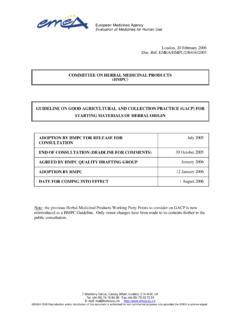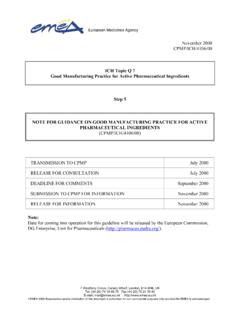Transcription of ROCKY MOUNTAIN JUNIPER - USDA PLANTS
1 Plant Guide mixed with Populus leaves this root tea became a ROCKY MOUNTAIN liniment for stiff back or backaches (McClintock 1909, Johnston 1970, Hellson 1974). JUNIPER . The Cheyennes steeped the leaves of the ROCKY Juniperus scopulorum Sarg. MOUNTAIN JUNIPER and drank the resulting tea to Plant Symbol = JUSC2 relieve persistent coughing or a tickling in the throat. It was also believed to produce sedative effects that Contributed by: USDA NRCS National Plant Data were especially useful for calming a hyperactive Center person. Cheyenne women drank JUNIPER tea to speed delivery during childbirth (Grinnell 1962).
2 The Cheyenne, along with the Flathead, Nez Perce, Kutenai, and Sioux, made a tea from JUNIPER boughs, branches, and fleshy cones. The tea was used as a cure for colds, fevers, tonsillitis, and pneumonia (Hart 1976). As a cure for asthma, the Gros Ventres ate whole JUNIPER berries or pulverized them and boiled them to make a tea. They also made a preparation from the leaves mixed with the root, which they applied topically to control bleeding (Kroeber 1908). The Crow drank this medicinal tea to check diarrhea and to stop lung or nasal hemorrhage. Crow women drank it after childbirth for cleansing and healing (Hart 1976).
3 The wood of red cedar is very durable, and is used for lance shafts, bows, and other items. Flutes made from JUNIPER wood were highly regarded by the Cheyenne. Ornamental: All of the native junipers are valuable ornamental species, and many horticultural varieties Horticulture: Landscape PLANTS have been developed. ROCKY MOUNTAIN JUNIPER is Oregon State University widely used in shelterbelts and wildlife plantings. The close-grained, aromatic, and durable wood of Alternative Names junipers is used for furniture, interior paneling, cedar tree, JUNIPER , JUNIPER bush, savin, evergreen, novelties, and fence posts.
4 The fruits and young cedar apple, ROCKY MOUNTAIN cedar branches contain aromatic oil that is used in medicines. Uses Ethnobotanic: ROCKY MOUNTAIN JUNIPER was and still Wildlife: Junipers are important to wildlife is used by many tribes for incense in purification and throughout the country. Their twigs and foliage are ritual (Kindscher 1992). The Blackfeet made a tea eaten extensively by hoofed browsers, but the chief from the berries of the ROCKY MOUNTAIN JUNIPER to attraction to wildlife is the bluish-black berry-like stop vomiting (Kindscher 1992). A Blackfeet fruit.
5 The cedar waxwing is one of the principal remedy for arthritis and rheumatism was to boil users of JUNIPER berries, but numerous other birds and JUNIPER leaves in water, add one-half teaspoon of mammals, both large and small, make these fruits and turpentine, and when cooled, rub the mixture on important part of their diet. In addition to their affected parts. The Blackfeet also drank a tea made wildlife food value, junipers provide important from Juniperus scopulorum root as a general tonic; protective and nesting cover. Chipping sparrows, Plant Materials < >.
6 Plant Fact Sheet/Guide Coordination Page < >. National Plant Data Center < >. robins, song sparrows, and mockingbirds use these starts its new growth. It is especially well adapted to trees as one of their favorite nesting sites. Juncos, dry areas. The junipers are generally propagated by myrtle warblers, sparrows of various kinds, and other cuttings. birds use the dense foliage as roosting cover. In winter their dense protective shelter is especially Propagation from Cuttings valuable. Cuttings are made 5 to 15 cm (2 to 65 inches) long from new lateral growth tips stripped of older Description branches.
7 A small piece of old wood, a heel, is General: Cypress Family (Cupressaceae). ROCKY thus left attached to the base of the cutting. Some MOUNTAIN cedar (Juniperus scopulorum ) is a medium propagators believe this to be advantageous. In other sized dioecious or rarely monoecious tree from 10-20 cases, good results are obtained when the cuttings are m (33-66') tall (McGregor et al. 1986, Stephens just clipped without the heel from the older wood. 1973). The evergreen tree is scraggly with rounded Cuttings from the current season's terminal growth crown to pyramidal.
8 The bark is dark reddish-brown also root well. to grayish in color, thin, fibrous, and usually shreds with age. Leaves are green or blue-green, usually Cuttings to be rooted in the greenhouse can be taken barely overlapping and closely appressed, scalelike at any time during the winter or rooted outdoors on and cm (1/16-1/8") long or needlelike and heated beds. Exposing the stock PLANTS to several cm (1/4-1/2") long. Recessed glands occur on hard freezes seems to give better rooting. Optimum the dorsal side of the leaves. Juniperus scopulorum time for taking cuttings is when stock PLANTS have differs from red cedar (J.)
9 Virginiana) by the blunt ceased growth ( the late fall-winter propagation leaves, the leaves not overlapping, and the longer, period is more successful than summer). For elliptic glands. The fruits of J. scopulorum mature in propagating in an outdoor cold frame, cuttings are the second season, while in J. virginiana fruits taken in late summer or early fall. There may be mature in the first season. Juniperus scopulorum is advantages to using bottom heat. Lightly wounding usually a more rounded tree and J. virginiana is more the base of the cuttings is sometimes helpful, and the conical.
10 Use of root-promoting chemicals, especially IBA, is beneficial. Recommendations for root-promoting Male and female cones are on separate trees. The chemicals include the following: 2500 IBA Quick- staminate (male) cones are yellowish-brown, papery, dip (Alabama), 3000 8000 ppm IBA liquid, and solitary at the tips of branchlets, ovoid to ellipsoid, percent IBA talc. A medium-coarse sand or a and cm (1/16-1/8") long. The ovulate 10:1 mixture of perlite and peat moss is a satisfactory (female) cones are solitary at the tips of branchlets, rooting medium. Maintenance of a humid dark blue or bluish-purple, waxy and berry-like, and environment without excessive wetting of the cm (3/16-1/4") long.

















